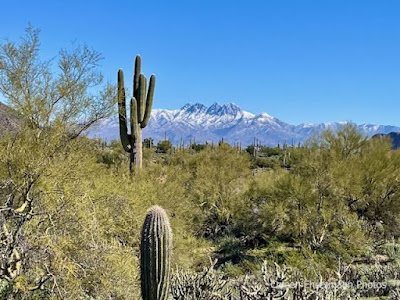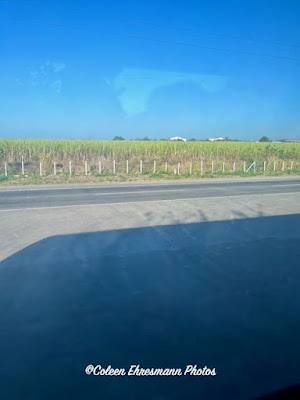Our cruise ship docked in Guatemala at the port of Puerto Quetzal, several miles from San Jose and 1.5 hours from our excursion choice of Antigua, the third capital of Guatemala. Antigua is known for its coffee and volcanoes. The population at its peak in the 1770s was 60,000. Today the population is around 35,000. Because of its outstanding Spanish Baroque-influenced architecture, layout, churches, and ruins, and the city's importance during the early colonial period of the country, Antigua Guatemala was designated as a UNESCO World Heritage Site in 1979. ~Wikipedia
We rode an air-conditioned bus with a tour guide who shared wonderful information about his country.
We passed fields of sugar cane in various stages of harvest. For more interesting info on raising sugar cane, check it out on
Wikipedia. A stalk can produce up to 10 harvests, but more likely 2-5. We did see burning fields which are harvested by hand and also saw fields which had been harvested by machine. We also saw milling plants. Hawaii no longer produces sugar cane.
We also passed fields of bananas. Bananas are grown by transplanting part of the stem, creating a new plant from an existing one. It takes the new plant one year to reach maturity; the fruit takes an additional three months to reach the harvest point. The fruit is harvested by bananeros in the field while green, hard and completely unripe.
We saw fields of coffee beans closer to the outskirts of Antigua.
Volcanoes Fuego (fire) to the left and Acatenango on the right. Fuego is famous for being almost constantly active at a low level. Steam and gas issue from its top almost daily, while a larger eruption occurred in September 2012. Acatenango last erupted in 1972. On the right side of the bus was the volcano Aqua (water). I do not have a photo of it.
One of two cemeteries we passed along the way to Antigua.
Antigua Guatemala Cathedral
Originally built in 1541 this Roman Catholic church was demolished in 1169 due to damage from several earthquakes. It was rebuilt in 1680 and by 1743 is was one of the largest in Central America. A devastating 1773 earthquake seriously damaged the church once again. Only the two towers remained largely intact. Today only a sliver of the original church building remains. The rest of the 1680 building is in ruins behind this structure.
the massive wooden doors had smaller walk through doors
the inside was ornate and beautiful, if small
Our guide told us because of the price of gasoline, many locals ride scooters. Click on the photo to see a better photo of the cobbled streets, narrow cobbled streets.
Then we walked to Central Park. Hubby is walking to the left of this gentleman and his cute little cart. I honestly don't know what the carts were selling, but each was equipped with a pump bottle of hand sanitizer. There were several of these cute little vehicle carts along the street at the park.
There were also 3 of these cute motorized old fashioned cars available for hire. Notice the doorways and painted businesses and homes across from the park.
The mermaid fountain was designed by Diego de Porres and built in 1738. It is the center piece of the Parque Central or Main Plaza.
Church of Our Lady of Mercy
stunning vivid detail on the facade
This baroque style Roman Catholic church was originally built in 1548 and destroyed twice by earthquakes. It was rebuilt in 1700 to withstand earthquakes and is the best restored and preserved church in the city.
Local women and men were selling their handcrafted items in the parking lot around the church, in the park, along the streets, everywhere tourists might be.
map of the city center
The town was built in a grid style inspired by the Italian Renaissance.
Santa Catalina Arch
Built in 1694 the Santa Catalina Arch is the symbol of Antigua. On either side of the arch are two convents. Cloistered nuns lived on one side of the arch and taught at the school on the other side. The nuns had taken vows of seclusion and had to avoid all contact with the outside world including being seen in public. The arch was built with a hidden passageway allowing the nuns to cross the street without being seen. The arch has suffered earthquake damages numerous times over the years. The clock added in the 1800s needs to be wound every 3 days. I believe it is still an active cloister.
The little car in the foreground is a taxi large enough for the driver and a passenger in the back.
Antiguo Colegio de la Compañía de Jesús Church
This Jesuit monastery and college was established in 1626. The order was expelled in 1767 and an earthquake in 1773 left it in ruins. The Spanish government refurbished the complex as a cultural center. It now contains lecture halls, exhibit spaces, a cafe and excellent library. The church (in the photo) remains unrestored. The cultural center is the building on the right.
Antigua Guatemala Cathedral (San Jose Cathedral)
Antigua's cathedral was begun in 1545, wrecked by the quake of 1773, and only partially rebuilt over the next century. The present sliver of a church – the parish of San José – occupies only the entrance hall of the original edifice. Behind it are the roofless ruins of the main part of the cathedral.
An earthquake in 1976 was the latest to damage this old building. It is just a facade to ruins. It is located across from the Central Park which may be why the facade was rebuilt after the damage from the last earthquake. It is well lit at night.
The main part of the cathedral was built in the 17th century by Joseph de Porres, an architect of African-Maya descent. This is just some of the ruins behind the facade. For a small entrance fee, one could enter and explore this 400 year old church. We saw this section before reaching the park and seeing the well preserved front of the church.
Church of Saint Francis
This is one of the most frequented sanctuaries by the locals. Built in 1579, it too has suffered major damage from the earthquakes over the years. San Francisco el Grande became a significant religious and cultural center for the whole region. Theology, law, philosophy, physics and mathematics were taught at San Buenaventury College, located in today's monastery ruins. The college also favored painters of the colonial era such as Cristóbal de Villalpando, Thomas de Merlo and Alonzo de la Paz. Its facade, with twisted salomonic columns, is typical of the Spanish-American baroque and is similar to that of San José Cathedral. ~Wikipedia
colorful buildings along one of the streets
We completed the Adventure Lab then went in search of food.
Birds of Paradise as bouquets
no food here but it did have restrooms
OFD led us to this place with only one wrong turn.
There was a beer tasting session happening on the main floor with some folks from our cruise ship in attendance. The brew master was from Texas and was a teacher in an earlier lifetime. He took a trip to Antigua, met the guy who is the cook at the brew house and they became business partners.
our lunch beverages
delicious nachos which we shared
that is white cheese on the top...not green!
then it was shopping time before heading back to the bus
this store had everything we wanted
Parish of Our Lady of Remedies
This ruin was located across from the bus parking. Built as a hermitage in 1575 and damaged by numerous earthquakes and a 1762 mud flood, it is considered one of the oldest temples in Antigua. (All the statues are headless, but still standing.)
Antigua is known as a destination for people who want to learn Spanish through immersion. There are many Spanish language schools in Antigua, and it is one of the most popular and best recognized centers for studying the Spanish language by students from Europe, Asia, and North America. Language institutes are one of the primary industries of Antigua, along with tourism. ~Wikipedia And the three of us did what we could to help the economy.








































































